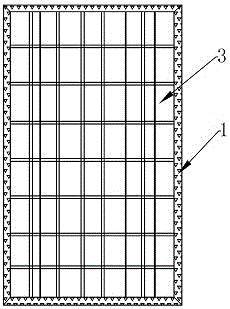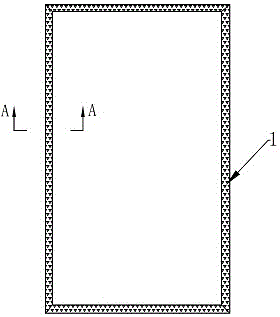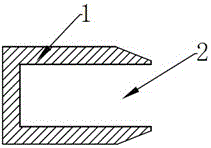A solar panel frame and solar panel assembly based on 3D printing technology
A solar module and 3D printing technology, applied in electrical components, photovoltaic power generation, photovoltaic modules, etc., can solve problems such as soil erosion, paralysis, power generation failure, etc., and achieve the effect of maintaining strength, reducing weight, and simple structure
- Summary
- Abstract
- Description
- Claims
- Application Information
AI Technical Summary
Problems solved by technology
Method used
Image
Examples
Embodiment 1
[0032] Such as Figure 1 to Figure 4 As shown, in the solar module frame 1 based on 3D printing technology in Embodiment 1, the inner surface of the solar module frame 1 is provided with a component card slot 2 for embedding the solar module 3, and the outer surface of the solar module frame 1 is provided with a first-level blind The holes 4 and the bottom surface of the primary blind hole 4 are provided with secondary blind holes 5 at intervals, and the orifices of the secondary blind holes 5 are evenly distributed on the bottom surface of the primary blind hole 4 .
[0033] In this embodiment, the opening width of the first-level blind holes 4 is not greater than 1 / 5 of the width of the corresponding solar module frame 1; the first-level blind holes 4 are arranged in a matrix on the outer surface of the solar module frame 1, and the second-level blind holes 5 The shape and size of the first-level blind hole 4 are spherical, and the opening of the first-level blind hole 4 loc...
Embodiment 2
[0036] Such as Figure 5 As shown, the difference between embodiment 2 and embodiment 1 is that the primary blind holes 4 of two adjacent rows are arranged in dislocation; A honeycomb mesh surface composed of squares.
[0037] In the honeycomb grid surface formed by combining several corresponding squares, the square openings in two adjacent rows can be arranged in dislocation. The tensile strength of the frame of this structural component is about 215MPa.
Embodiment 3
[0039] Such as Image 6 As shown, the difference between embodiment 3 and embodiment 1 is that the first-level blind hole 4 includes a first-level blind hole 4-1 and a second-level blind hole 4-2, and the first-level blind hole 4-1 The orifice area is larger than the orifice area of the second-level blind hole 4-2, and the first-level blind hole 4-1 and the second-level blind hole 4-2 are arranged in a matrix on the outer surface of the solar module frame 1, The second-level blind hole 4-2 is arranged at the diagonal intersection of four adjacent first-level blind holes 4-1 arranged in a square; the second-level blind hole 5 is a regular hexagonal pyramid, and the first-level blind hole The hole bottoms of 4-1 and the second-level blind hole 4-2 are both honeycomb grid surfaces composed of several regular hexagons. The tensile strength of the frame of this structural component is about 210MPa.
PUM
 Login to View More
Login to View More Abstract
Description
Claims
Application Information
 Login to View More
Login to View More - R&D
- Intellectual Property
- Life Sciences
- Materials
- Tech Scout
- Unparalleled Data Quality
- Higher Quality Content
- 60% Fewer Hallucinations
Browse by: Latest US Patents, China's latest patents, Technical Efficacy Thesaurus, Application Domain, Technology Topic, Popular Technical Reports.
© 2025 PatSnap. All rights reserved.Legal|Privacy policy|Modern Slavery Act Transparency Statement|Sitemap|About US| Contact US: help@patsnap.com



